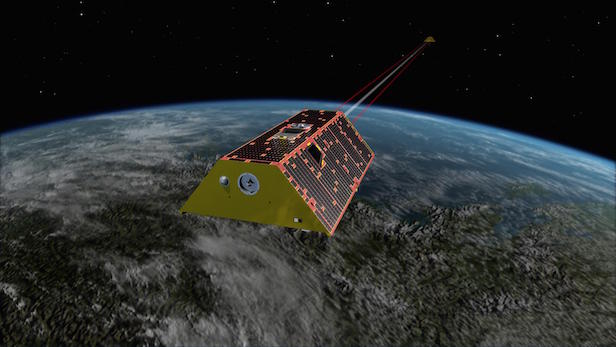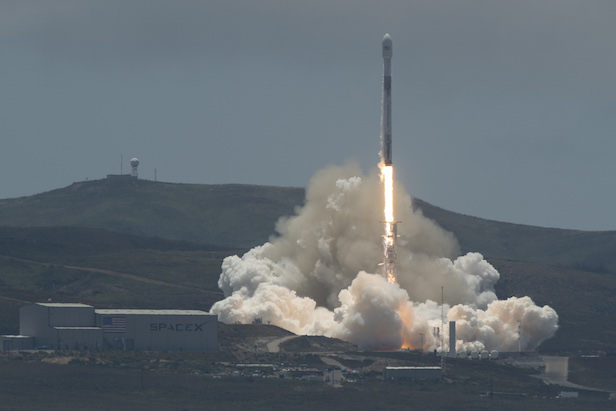GRACE-FO twin satellites have been launched successfully
The next generation of satellites that will closely monitor Earth’s water movement are now accommodated in space

GRACE-FO is a collaborative effort from both NASA and the German Research Centre for Geosciences. Image credit: NASA/JPL-Caltech
The Gravity Recovery and Climate Experiment Follow-On (GRACE-FO) mission, built in partnership between NASA and the German Research Centre for Geosciences (GFZ), was successfully launched on 22 May 2018 at 7:47pm GMT (12:47pm PDT) from California, Untied States. The twin spacecraft will now track the perpetual movement of water and other changes in Earth’s mass on and beneath the planet’s surface.
GRACE-FO was launched via a SpaceX Falcon 9 rocket from Space Launch Complex 4E at Vandenberg Air Force Base in California, United States. It shared its ride with five Iridium NEXT communications satellites. Since the launch all signs have been positive from the ground stations, which have acquired signals from both GRACE-FO spacecrafts. According to initial telemetry, the satellites appear to be functioning as expected as they orbit Earth at an altitude of 490 kilometres (305 miles), travelling at a speed of 7.5 kilometres per second (16,800 miles per hour). In this near-polar orbit, GRACE-FO completes one orbit of Earth every 90 minutes.
“GRACE-FO will provide unique insights into how our complex planet operates,” says Thomas Zurbuchen, associate administrator of NASA’s Science Mission Directorate at NASA Headquarters in Washington, United States. “Just as important, because the mission monitors many key aspects of the Earth’s water cycle, GRACE-FO data will be used throughout the world to improve people’s lives – from better predictions of drought impacts to higher quality information on use and management of water from underground aquifers.”
Over the course of its five-year mission, these twin satellites will watch the motion of mass on our planet by measuring where and how this mass changes the Earth’s gravitational pull. Any change in the Earth’s gravity will change the distance between the two satellites ever so slightly. Although the two satellites will orbit Earth 220 kilometres (137 miles) apart, their precise instrumentation will be able to measure their separation to within the width of a human red blood cell.

GRACE-FO was launched onboard a SpaceX Falcon 9 rocket from Space Launch Complex 4E at Vandenberg Air Force Base in Caifornia, United States. Image credit: NASA/B. Ingalls
GRACE-FO is a continuation of the original GRACE mission, which was again a collaborative mission between the United States and Germany that operated between 2002 and 2017. For 15 years the GRACE mission produced detailed monthly maps of regional gravity variations, thus providing valuable insight into how the Earth undergoes systematic changes and how it adapts. “This mission continues and advances an amazing achievement of science and technology pioneered by the United States and Germany,” says Zurbuchen.
GRACE was the first mission to measure the amount of ice being lost from the Greenland and Antarctic ice sheets. This was fundamental in our understanding of how climate change is affecting the Earth and causing sea levels to rise. Not only did GRACE provide scientists with a better understanding of the processes responsible for rising sea levels and ocean circulation, it also provided insight into where global groundwater resources are shrinking or growing, where dry soils are contributing to drought and also monitored changes in the solid Earth, for example from earthquakes.
Frank Webb, GRACE-FO project scientist at NASA’s Jet Propulsion Laboratory in Pasadena, California, United States, made the point that in order to understand the changes that are taking place because of climate change, scientists must examine data recorded over several decades. “Extending the data record from GRACE will allow us to better distinguish short-term variability from longer term trends,” says Webb.
For the first few days of GRACE-FO’s missions, the satellites will be moving around in space and making sure they have the correct separation distance needed to perform the mission. Once the separation distance is met the mission will begin an 85-day, in-orbit checkout phase. The mission managers will then evaluate the instruments and satellite systems while performing the proper calibration and alignment procedures to ensure the highest quality data retrieval. After this the data gathering and processing can commence. The first set of scientific data is expected to be released around December 2018.
Keep up to date with the latest reviews in All About Space – available every month for just £4.99. Alternatively you can subscribe here for a fraction of the price!




